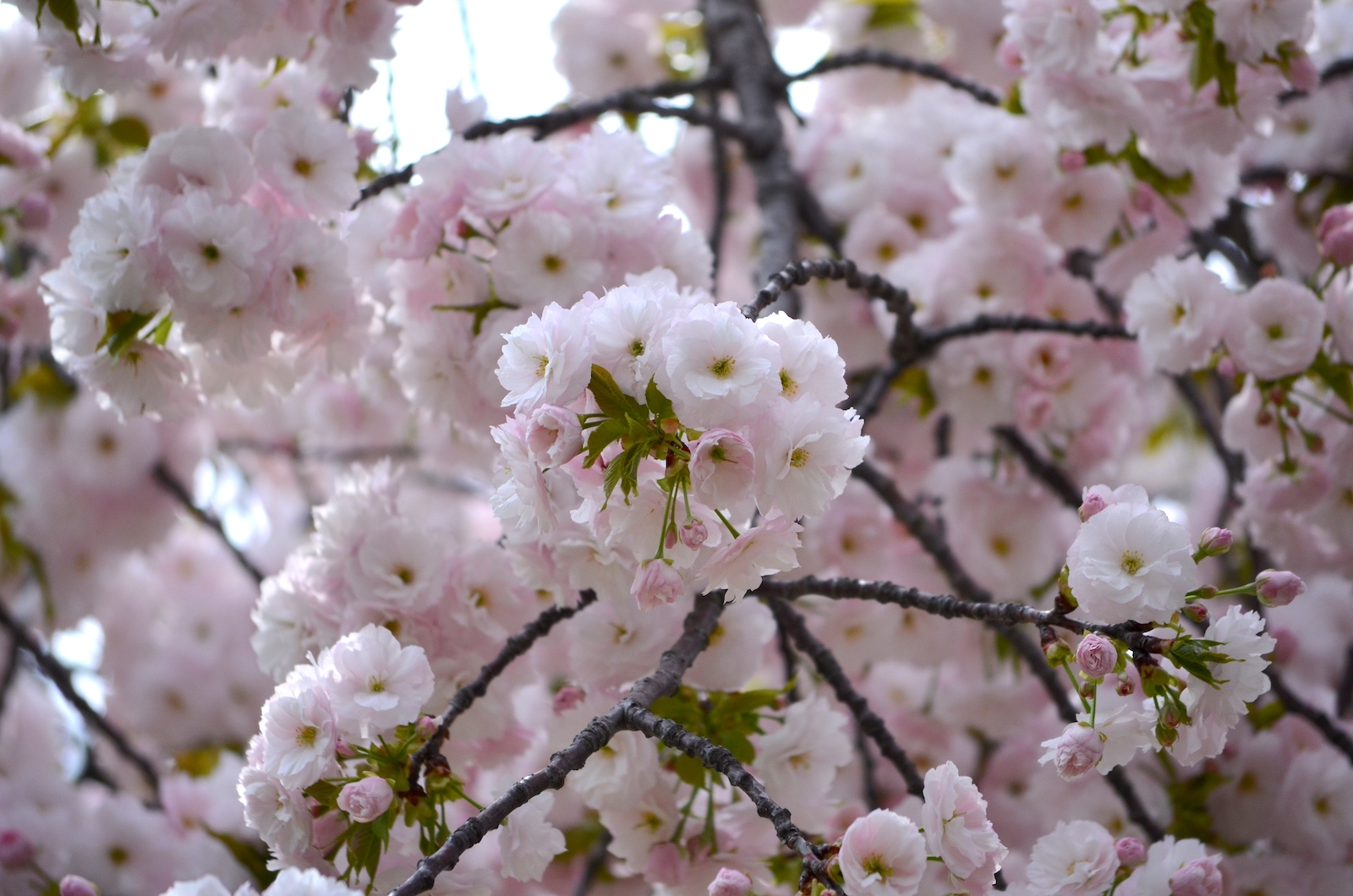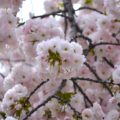The cherry blossom period is the most beautiful, hence the most popular (and therefore most crowded) time to visit Japan. A large section of the deciduous trees in Japan are cherry trees, which is why the beginning of spring is marked by a sea of pink and white cherry blossoms covering the whole country. Even in the megacity of Tokyo you can experience this beautiful spectacle of nature. The Japanese themselves are just as fascinating to watch during this spectacle as those gorgeous cherry blossoms. The locals all gather at the city parks for photo sessions, picnics and to stroll around.
The Japanese cherry blossom (sakura) is regarded as one of the most important symbols of the Japanese culture. As their national flower, it symbolizes a fresh start as well as beauty, but due to its short blooming period (about 10 days) at the same time represents the evanescence of this beauty. Cherry blossoms start blooming mid-March in the south of Japan, in Kyūshū, and wander towards the northeast until the blossom period finally arrives in Hokkaidō in early May.
Not only on the weekends do thousands crowd Tokyos parks to celebrate Hanami (Jap. for “flower viewing”). They’re equipped with huge cameras and big blue plastic rugs (I don’t know if there’s a symbolic reason or if they just all get those blue blankets at the popular 100 Yen stores) when they go outside to enjoy the natural spectacle. In the evenings it’s popular among students and colleagues to get together with some beer, sake and bento boxes to celebrate Hanami.

Shinjuku Gyoen Park is a bit more peaceful and family friendly. It’s one of the largest and most popular parks in Tokyo and just a short walk from Shinjuku Station. Marshals (s. picture) take care of the drinking ban being observed in this park. Over 1300 cherry blossom trees with over 65 different types are planted on the grounds of Shinjuku Gyoen Park. Due to this variety, here you can see cherry blossoms from February to the end of April: while some cherry blossoms may have faded already, others are just about to open their blossoms. That’s just what it was like when we were in Tokyo towards the end of cherry blossom time mid-April a few years ago. Obviously I couldn’t miss the chance of capturing a few impressions with my camera. Strictly speaking, it was a borrowed camera, which I didn’t exactly know how to use. However, I think I still got a few great pictures of the main attraction – the cherry blossom – plus a few other snapshots.
All the way down this post, you’ll find more information and links.

Shinjuku Gyoen Park
- Opening hours: Tuesday – Sunday, 09:00 – 16:30 (admittance until 16:00)
- Closed days: Mondays (if it’s a holiday, the park will be closed on the following Tuesday as well)
- Entrance fee: 200 Yen/ adults; 50 Yen/ children
- There’s a good chance to see cherry blossoms even at the end of March/ beginning of April in this park
- Access via three gates:
- Shinjuku-Gate (s. picture below): 10 minute walk from “Shinjuku Station” (New South Exit) or 5 minutes from “Shinjukugyoenmae” station
- Okido-Gate: 5 minute walk from “Shinjukugyoenmae” station
- Sendagaya-Gate: 5 minute walk from “JR Sendagaya” station
- You can find more information on this website (English)



















































Further information
Time: You can find the current time on this site.
Visa: Depending on your nationality, tourists and business travelers of most countries don’t need a visa for a duration of stay up to 180 days. In this case you’ll get permission to stay for 90 days on arrival, which you can extend later. You’ll find more information concerning visa requirements for Japan at the foreign office of your country.
Currency: Japenese Yen (¥) – you can find the current exchange rate here.
In Japan you drive on the left.
Important holidays
If a holiday falls on a Sunday, it will be observed on the following Monday. If that Monday happens to be a holiday itself, it will be observed on the following Tuesday. If there are two holidays with only one day in between – e.g. Tuesday and Thursday – Wednesday (in this case) will be a holiday as well.
- Ganjitsu (New Year’s Day): (January 1st)
- Seijin-no-hi (Coming of Age Day): always the second Monday of January (January 8th 2018, January 14th 2019)
- Kenkoku Kinem-bi (Foundation Day): February 11th
- Kenpo Kinem-bi (Constitution Memorial Day): May 3rd
- Midori-no-hi (Greenery Day): Mai 4th
- Kodomo-no-hi (Children’s Day): Mai 5th
- Umi-no-hi (Marine Day): third Monday of July (July 16th 2018, July 15th 2019)
- Yama-no-hi (Mountain Day): August 11th (initially 2016)
- Obon (Day of the Dead): August 13.-15. – no official national holiday, even though a traditional Buddhist celebration
Tipping: Not only is tipping uncommon in Japan, but often an insult. In Japan perfect service is considered a matter of course, which shouldn’t be paid extra. In a country, where serving isn’t considered as being inferior to other jobs, the relation between the servant and the one being served would be out of balance with a monetary bonus. So even if it counters with our understanding of appreciating good service, there’s no tipping in Japan.
Founding: Japan: February 11th, 660 BC
Population: Japan: 127 million / Tokyo: 9.4 million / Tokyo (metropolitan area): 38 million
Population per km²: Japan: 336 / Tokyo: 15,112
Area: Japan: 377,962 km² / Tokyo: 622 km²
Official language: Japanese
Cherry blossom time is probably the most beautiful time in Tokyo (end of March – beginning of April), hence the peak season. At this time many Japanese travel within the country, which is why trains and accommodations may be fully booked for a long time ahead. In June and July you can expect a lot of rain all over Japan (except for Hokkaido). From the end of June until August it may also be oppressively hot in the city. As opposed to the hot and humid summer months, in autumn (October and November) the air is clear and temperatures are quite pleasant. In the winter (December – February) it gets so cold, you probably won’t want to be outside for very long – unless skiing is what you’re after.
The time around the Day of the Dead (“Obon Week”, August 13th – 15th – s. above) is one of the peak seasons of the Japanese. The same goes for the Golden Week (April 29th – May 5th, s. holiday above). If possible, avoid traveling within Japan or to Mount Fuji during these times (otherwise only with reservations for trains etc. beforehand). We climbed the Fuji during Obon Week (unknowingly) and it felt like the entire Japanese population was there with us, even though we were told everyone would travel home to the countryside to visit their families..
Fuji: The official mountain climbing season is from the 1st of July until August 31st. The ascent is also possible off-season, but Japanese authorities warn against doing so, reasoning it with the weather which can be unpredictable or can change abruptly. Besides, most mountain huts wouldn’t be open off-season. In any case, you should check the weather beforehand, e.g. on this site.
It’s also worth knowing, that virtually all the stores, restaurants and sights are closed around New Year’s (December 31st – January 03rd)




